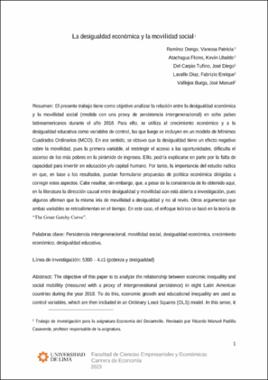La desigualdad económica y la movilidad social

Ver/
Descargar
(application/pdf: 348.5Kb)
(application/pdf: 348.5Kb)
Fecha
2023Autor(es)
Asesor(es)
Metadatos
Mostrar el registro completo del ítemResumen
El presente trabajo tiene como objetivo analizar la relación entre la desigualdad económica y la movilidad social (medida con una proxy de persistencia intergeneracional) en ocho países latinoamericanos durante el año 2018. Para ello, se utiliza al crecimiento económico y a la desigualdad educativa como variables de control, las que luego se incluyen en un modelo de Mínimos Cuadrados Ordinarios (MCO). En ese sentido, se obtuvo que la desigualdad tiene un efecto negativo sobre la movilidad, pues la primera variable, al restringir el acceso a las oportunidades, dificulta el ascenso de los más pobres en la pirámide de ingresos. Ello, podría explicarse en parte por la falta de capacidad para invertir en educación y/o capital humano. Por tanto, la importancia del estudio radica en que, en base a los resultados, puedan formularse propuestas de política económica dirigidas a corregir estos aspectos. Cabe resaltar, sin embargo, que, a pesar de la consistencia de lo obtenido aquí, en la literatura la dirección causal entre desigualdad y movilidad aún está abierta a investigación, pues algunos afirman que la misma iría de movilidad a desigualdad y no al revés. Otros argumentan que ambas variables se retroalimentan en el tiempo. En este caso, el enfoque teórico se basó en la teoría de “The Great Gatsby Curve”. The objective of this paper is to analyze the relationship between economic inequality and social mobility (measured with a proxy of intergenerational persistence) in eight Latin American countries during the year 2018. To do this, economic growth and educational inequality are used as control variables, which are then included in an Ordinary Least Squares (OLS) model. In this sense, it was found that inequality has a negative effect on mobility, since the first variable, by restricting access to opportunities, makes it difficult for the poorest to rise in the income pyramid. This could be partly explained by the lack of capacity to invest in education and/or human capital. Therefore, the importance of the study lies in the fact that, based on the results, economic policy proposals aimed for correcting these aspects can be formulated. It should be noted, however, that, despite the consistency of what was obtained here, in the literature the causal direction between inequality and mobility is still open to investigation, since some affirm that this would go from mobility to inequality and not the other way around. Others argue that both variables feed back over time. In this case, the theoretical approach was based on the theory of “The Great Gatsby Curve”.
Cómo citar
Ramírez Dongo, V. P., Atachagua Flores, K. U., Del Carpio Tufino, J. D., Lavalle Diaz, F. E. & Vallejos Burga, J. M. (2023). La desigualdad económica y la movilidad social [trabajo de fin de curso]. Universidad de Lima, Facultad de Ciencias Empresariales y Económicas, Carrera de Economía. https://hdl.handle.net/20.500.12724/17972Editor
Universidad de LimaTemas
Nota
Trabajo de investigación para la asignatura Economía del Desarrollo. Revisado por el profesor Ricardo Manuel Padilla Casaverde, responsable de la asignatura.
Coleccion(es)
- Economía [59]
El ítem tiene asociados los siguientes ficheros de licencia:

